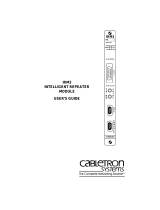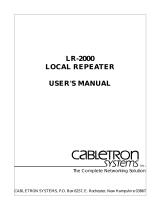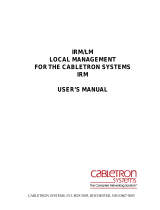Page is loading ...

FOMIM-32/36/38 FIBER OPTIC
MEDIA INTERFACE MODULE
USER’S GUIDE

FOMIM User’s Guide i
NOTICE
Cabletron Systems reserves the right to make changes in specifications and other information
contained in this document without prior notice. The reader should in all cases consult Cabletron
Systems to determine whether any such changes have been made.
The hardware, firmware, or software described in this manual is subject to change without notice.
IN NO EVENT SHALL CABLETRON SYSTEMS BE LIABLE FOR ANY INCIDENTAL,
INDIRECT, SPECIAL, OR CONSEQUENTIAL DAMAGES WHATSOEVER (INCLUDING BUT
NOT LIMITED TO LOST PROFITS) ARISING OUT OF OR RELATED TO THIS MANUAL OR
THE INFORMATION CONTAINED IN IT, EVEN IF CABLETRON SYSTEMS HAS BEEN
ADVISED OF, KNOWN, OR SHOULD HAVE KNOWN, THE POSSIBILITY OF SUCH
DAMAGES.
Copyright 1996 by Cabletron Systems, Inc., P.O. Box 5005, Rochester, NH 03866-5005
All Rights Reserved
Printed in the United States of America
Order Number: 9030524-01 July 1996
SPECTRUM
,
LANVIEW
,
MicroMMAC
, and
BRIM
are registered trademarks and
Element
Manager
,
EPIM
,
EPIM-A
,
EPIM-F1
,
EPIM-F2
,
EPIM-F3
,
EPIM-T
,
EPIM-X
,
FOMIM,
FOT-F
,
FOT-F3
,
HubSTACK
,
SEH
,
SEHI
, and
TMS-3
are trademarks of Cabletron Systems, Inc.
All other product names mentioned in this manual may be trademarks or registered trademarks of
their respective companies.
FCC NOTICE
This device complies with Part 15 of the FCC rules. Operation is subject to the following two
conditions: (1) this device may not cause harmful interference, and (2) this device must accept any
interference received, including interference that may cause undesired operation.
NOTE:
This equipment has been tested and found to comply with the limits for a Class A digital
device, pursuant to Part 15 of the FCC rules. These limits are designed to provide reasonable
protection against harmful interference when the equipment is operated in a commercial environment.
This equipment uses, generates, and can radiate radio frequency energy and if not installed in
accordance with the operator’s manual, may cause harmful interference to radio communications.
Operation of this equipment in a residential area is likely to cause interference in which case the user
will be required to correct the interference at his own expense.
WARNING:
Changes or modifications made to this device which are not expressly approved by the
party responsible for compliance could void the user’s authority to operate the equipment.
Printed on Recycled Paper
This document was created with FrameMaker 4.0.2
notice Page i Monday, July 8, 1996 4:38 PM

Notice
ii FOMIM User’s Guide
DOC NOTICE
This digital apparatus does not exceed the Class A limits for radio noise emissions from digital
apparatus set out in the Radio Interference Regulations of the Canadian Department of
Communications.
Le présent appareil numérique n’émet pas de bruits radioélectriques dépassant les limites applicables
aux appareils numériques de la class A prescrites dans le Règlement sur le brouillage radioélectrique
édicté par le ministère des Communications du Canada.
VCCI NOTICE
This equipment is in the 1st Class Category (information equipment to be used in commercial and/or
industrial areas) and conforms to the standards set by the Voluntary Control Council for Interference
by Information Technology Equipment (VCCI) aimed at preventing radio interference in commercial
and/or industrial areas.
Consequently, when used in a residential area or in an adjacent area thereto, radio interference may be
caused to radios and TV receivers, etc.
Read the instructions for correct handling.
CABLETRON SYSTEMS, INC. PROGRAM LICENSE AGREEMENT
IMPORTANT:
Before utilizing this product, carefully read this License Agreement.
This document is an agreement between you, the end user, and Cabletron Systems, Inc. (“Cabletron”)
that sets forth your rights and obligations with respect to the Cabletron software program (the
“Program”) contained in this package. The Program may be contained in firmware, chips or other
media. BY UTILIZING THE ENCLOSED PRODUCT, YOU ARE AGREEING TO BECOME
BOUND BY THE TERMS OF THIS AGREEMENT, WHICH INCLUDES THE LICENSE AND
THE LIMITATION OF WARRANTY AND DISCLAIMER OF LIABILITY. IF YOU DO NOT
AGREE TO THE TERMS OF THIS AGREEMENT, PROMPTLY RETURN THE UNUSED
PRODUCT TO THE PLACE OF PURCHASE FOR A FULL REFUND.
notice Page ii Monday, July 8, 1996 4:38 PM

Notice
FOMIM User’s Guide iii
CABLETRON SOFTWARE PROGRAM LICENSE
1. LICENSE
. You have the right to use only the one (1) copy of the Program provided in this
package subject to the terms and conditions of this License Agreement.
You may not copy, reproduce or transmit any part of the Program except as permitted by the
Copyright Act of the United States or as authorized in writing by Cabletron.
2. OTHER RESTRICTIONS. You may not reverse engineer, decompile, or disassemble the
Program.
3. APPLICABLE LAW. This License Agreement shall be interpreted and governed under the laws
and in the state and federal courts of New Hampshire. You accept the personal jurisdiction and
venue of the New Hampshire courts.
EXCLUSION OF WARRANTY AND DISCLAIMER OF LIABILITY
1. EXCLUSION OF
WARRANTY. Except as may be specifically provided by Cabletron in
writing, Cabletron makes no warranty, expressed or implied, concerning the Program (including
its documentation and media).
CABLETRON DISCLAIMS ALL WARRANTIES, OTHER THAN THOSE SUPPLIED TO
YOU BY CABLETRON IN WRITING, EITHER EXPRESSED OR IMPLIED, INCLUDING
BUT NOT LIMITED TO IMPLIED WARRANTIES OF MERCHANTABILITY AND
FITNESS FOR A PARTICULAR PURPOSE, WITH RESPECT TO THE PROGRAM, THE
ACCOMPANYING WRITTEN MATERIALS, AND ANY ACCOMPANYING HARDWARE.
2. NO LIABILITY FOR CONSEQUENTIAL DAMAGES. IN NO EVENT SHALL
CABLETRON OR ITS SUPPLIERS BE LIABLE FOR ANY DAMAGES WHATSOEVER
(INCLUDING, WITHOUT LIMITATION, DAMAGES FOR LOSS OF BUSINESS,
PROFITS, BUSINESS INTERRUPTION, LOSS OF BUSINESS INFORMATION, SPECIAL,
INCIDENTAL, CONSEQUENTIAL, OR RELIANCE DAMAGES, OR OTHER LOSS)
ARISING OUT OF THE USE OR INABILITY TO USE THIS CABLETRON PRODUCT,
EVEN IF CABLETRON HAS BEEN ADVISED OF THE POSSIBILITY OF SUCH
DAMAGES. BECAUSE SOME STATES DO NOT ALLOW THE EXCLUSION OR
LIMITATION OF LIABILITY FOR CONSEQUENTIAL OR INCIDENTAL DAMAGES, OR
ON THE DURATION OR LIMITATION OF IMPLIED WARRANTIES, IN SOME
INSTANCES THE ABOVE LIMITATIONS AND EXCLUSIONS MAY NOT APPLY TO
YOU.
UNITED STATES GOVERNMENT RESTRICTED RIGHTS
The enclosed product (a) was developed solely at private expense; (b) contains “restricted computer
software” submitted with restricted rights in accordance with Section 52227-19 (a) through (d) of the
Commercial Computer Software - Restricted Rights Clause and its successors, and (c) in all respects
is proprietary data belonging to Cabletron and/or its suppliers.
For Department of Defense units, the product is licensed with “Restricted Rights” as defined in the
DoD Supplement to the Federal Acquisition Regulations, Section 52.227-7013 (c) (1) (ii) and its
successors, and use, duplication, disclosure by the Government is subject to restrictions as set forth in
subparagraph (c) (1) (ii) of the Rights in Technical Data and Computer Software clause at
252.227-7013. Cabletron Systems, Inc., 35 Industrial Way, Rochester, New Hampshire 03867-0505.
notice Page iii Monday, July 8, 1996 4:38 PM

Notice
iv FOMIM User’s Guide
DECLARATION OF CONFORMITY
Application of Council Directive(s):
89/336/EEC
73/23/EEC
Manufacturer’s Name:
Cabletron Systems, Inc.
Manufacturer’s Address:
35 Industrial Way
PO Box 5005
Rochester, NH 03867
European Representative Name:
Mr. J. Solari
European Representative Address:
Cabletron Systems Limited
Nexus House, Newbury Business Park
London Road, Newbury
Berkshire RG13 2PZ, England
Conformance to Directive(s)/Product Standards:
EC Directive 89/336/EEC
EC Directive 73/23/EEC
EN 55022
EN 50082-1
EN 60950
Equipment Type/Environment:
Networking Equipment, for use in a
Commercial or Light
Industrial
Environment.
We the undersigned, hereby declare that the equipment packaged with this notice conforms to
the above directives.
Manufacturer Legal Representative in Europe
Mr. Richard Michaud Mr. J. Solari
___________________________________ ___________________________________
Full Name Full Name
Manager of Engineering Services Managing Director - E.M.E.A.
___________________________________ ___________________________________
Title Title
Rochester, NH, USA Newbury, Berkshire, England
___________________________________ ___________________________________
Location Location
notice Page iv Monday, July 8, 1996 4:38 PM

FOMIM User’s Guide v
CONTENTS
CHAPTER 1 INTRODUCTION
1.1 Using This Manual.......................................................................1-1
1.2 Document Conventions...............................................................1-3
1.3 Fiber Optic Media Interface Modules...........................................1-3
1.3.1 Distance and Cable Type ...............................................1-3
1.3.2 Multi Media Access Centers ...........................................1-4
1.4 LANVIEW Status Monitoring System ..........................................1-4
1.5 Related Manuals..........................................................................1-6
1.6 Getting Help.................................................................................1-6
CHAPTER 2 NETWORK REQUIREMENTS AND INSTALLATION
2.1 Network Cable Requirements......................................................2-1
2.1.1 Fiber Optic Network Design Guidelines..........................2-1
2.2 Unpacking the FOMIM.................................................................2-2
2.3 Installing the FOMIM into the MMAC...........................................2-3
2.4 Connecting Fiber Optic Cabling to the FOMIM............................2-4
CHAPTER 3 TESTING AND TROUBLESHOOTING
3.1 Installation Test ...........................................................................3-1
3.1.1 Testing the Fiber Optic Link Segment ............................3-1
3.1.2 Link Test .........................................................................3-2
3.2 Pre-Installation Test.....................................................................3-3
3.3 Using LANVIEW..........................................................................3-4
APPENDIX A FOMIM SPECIFICATIONS
INDEX

Contents
vi FOMIM User’s Guide

FOMIM User’s Guide 1-1
CHAPTER 1
INTRODUCTION
Welcome to the Cabletron Systems
FOMIM-32/36/38 Fiber Optic
Media Interface Module User’s Guide
. We have designed this manual
to serve as a simple installation and reference guide for the FOMIM, and
to explain the capabilities and special features of the module. Before
using the FOMIM, you need to carefully read through this manual to gain
a full understanding of the FOMIM and its capabilities.
Cabletron Systems offers three versions of 1300 nm single mode Fiber
Optic Media Interface Modules:
• FOMIM-32 providing 12 links with ST type connectors
• FOMIM-36 providing 6 links with ST type connectors
• FOMIM-38 providing 18 links with ST type connectors
1.1 USING THIS MANUAL
Chapter 1,
Introduction
, discusses the capabilities and special features of
the Cabletron Systems FOMIMs (Figure 1-1). This chapter also includes
a list of related manuals.
Chapter 2,
Network Requirements and Installation
, contains a list of
network requirements that must be met before you install the FOMIM and
instructions for installing the FOMIM into the MMAC chassis.
Chapter 3,
Testing and Troubleshooting
, provides procedures for testing
and troubleshooting the installation of the FOMIM. Instructions for using
LANVIEW, Cabletron Systems built-in visual diagnostic and status
monitoring system, are also included.
Appendix A,
FOMIM Specifications
, contains operational specifications
and environmental requirements for the FOMIM.

Chapter 1:
Introduction
1-2 FOMIM User’s Guide
Figure 1-1 The FOMIMs
It is assumed that you have a general working knowledge of Ethernet or
IEEE 802.3 type data communications networks and their physical layer
components.

Document Conventions
FOMIM User’s Guide 1-3
1.2 DOCUMENT CONVENTIONS
The following conventions are used throughout this document:
1.3 FIBER OPTIC MEDIA INTERFACE MODULES
Cabletron Systems Fiber Optic Media Interface Modules provide a choice
of six, twelve, or eighteen ports with ST connectors.
1.3.1 Distance and Cable Type
The FOMIMs support single mode fiber optic cable for sizes such as
8.3/125
µ
m, 8.7/125
µ
m, 9/125
µ
m, 10/125
µ
m, and 12/125
µ
m. The
cable distance is dependent on the cable type and the overall system fiber
optic budget. If the system budgets and timing constraints are met, then a
distance of up to 5 kilometers is possible. You can also use 62.5/125
µ
m
multimode cable with the FOMIM, but due to greater optical loss, signal
distance is reduced to 2 km.
NOTE
Note
symbol. Calls the reader’s attention to any item of
information that may be of special importance.
!
CAUTION
Caution
symbol. Contains information essential to avoid
damage to the equipment.
Warning
symbol. Warns against an action that could result in
equipment damage, personal injury or death.
NOTE
The FOMIM-32/36/38 use 1300 nm wavelength transmitters
and receivers (not the 850 nm specified by FOIRL) and should
be used only with the Cabletron Systems Ethernet single mode
transceiver, the FOT-F3.

Chapter 1:
Introduction
1-4 FOMIM User’s Guide
1.3.2 Multi Media Access Centers
The Cabletron Systems Fiber Optic Media Interface Modules are
designed to be installed into the Cabletron Systems Multi Media Access
Center (MMAC). The modular design of the MMAC allows the FOMIM
to co-exist with other Media Interface Modules (MIMs) to provide a
variety of different media connections on any one point.
Each packet entering the FOMIM is repeated by the repeater module in
the MMAC. Each packet that enters the repeater module is regenerated
and retimed, which assures data integrity and maximum data path
distance. In addition, the repeater feature ensures fault isolation, because
the repeater module automatically segments problem ports from the
network. A segmented port automatically reconnects to the network once
the port receives a good packet.
The repeater module also allows you to access the network management
capabilities that enable you to control the FOMIM and its attached
segments. For example, information on the number of good packets and
collisions that have passed through the FOMIM and each port on the
MIM can be gathered. For more information on managing the FOMIM,
refer to your specific management module Local Management Guide.
1.4 LANVIEW STATUS MONITORING SYSTEM
The FOMIM uses Cabletron Systems built-in visual diagnostic and status
monitoring system, LANVIEW. Using LANVIEW, network
troubleshooting personnel can quickly scan the LANVIEW LEDs to
observe network status, diagnose network problems, and determine which
node or segment is faulty (see Figure 1-2).

LANVIEW Status Monitoring System
FOMIM User’s Guide 1-5
Figure 1-2 LANVIEW LEDs
The following discusses the function of each LANVIEW LED on the
FOMIM (Figure 1-2). Note that there is one Link OK (LNK) and one
Receive (RCV) LED for each port on the MIM, as well as one Error
(ERR) and one Collision (CLN) LED for the entire MIM.
Link OK (LNK) LED
When lit, this green LED indicates that a link has been established
between the receive circuitry of the FOMIM and the transmit circuitry of
the fiber optic device at the other end of the link segment. This LED
remains lit as long as the link is maintained.
Receive (RCV) LED
When lit, this yellow LED indicates that a data packet is being received
on that port. The flash of the LED is pulse stretched for viewing effect.
Collision (CLN) LED
When lit, this red LED indicates that a collision is occurring on one of the
fiber segments attached to a fiber optic port on the FOMIM. The flash of
the LED is pulse stretched for viewing effect.
LANVIEW LEDs

Chapter 1:
Introduction
1-6 FOMIM User’s Guide
Error (ERR) LED
When lit, this red LED indicates the temperature within the MMAC
chassis has risen to 40
°
C or greater. The FOMIM alerts the management
board, and the FOMIM in turn receives a signal to light the LED.
1.5 RELATED MANUALS
The manuals listed below should be used to supplement the procedures
and other technical data provided in this manual. The procedures
contained in these manuals will be referenced, rather than repeated, in this
manual.
Cabletron Systems
Multi Media Access Center (MMAC-M3FNB,
MMAC-M5FNB, and MMAC-M8FNB) Overview and Set Up Guides
.
Cabletron Systems
FOT-F3 Fiber Optic Transceiver User's Manual.
1.6 GETTING HELP
If you need additional support related to this device, or if you have any
questions, comments, or suggestions concerning this manual, contact
Cabletron Systems Technical Support:
By phone (603) 332-9400
Monday – Friday; 8
A
.
M
. – 8
P
.
M
. Eastern Time
By CompuServe GO CTRON from any ! prompt
By Internet mail [email protected]
By FTP ctron.com (134.141.197.25)
Login
anonymous
Password
your email address
Before calling Cabletron Systems Technical Support, have the following
information ready:
• A description of the failure
• A description of any action(s) already taken to resolve the problem
(e.g., changing mode switches, rebooting the unit, etc.)
• A description of your network environment (layout, cable type, etc.)
• Network load and frame size at the time of trouble (if known)

Getting Help
FOMIM User’s Guide 1-7
• The serial and revision numbers of all Cabletron Systems products in
the network
• The device history (i.e., have you returned the device before, is this a
recurring problem, etc.)
• Any previous Return Material Authorization (RMA) numbers

Chapter 1:
Introduction
1-8 FOMIM User’s Guide

FOMIM User’s Guide 2-1
CHAPTER 2
NETWORK REQUIREMENTS AND
INSTALLATION
This chapter begins with network design guidelines in Section 2.1,
Network Cable Requirements
, that must be met before installing the
module in a network. It then provides instructions for installing the
Cabletron Systems Fiber Optic Media Interface Module into the MMAC
family of modular hubs.
2.1 NETWORK CABLE REQUIREMENTS
When connecting fiber optic segments to the FOMIM, you must follow
the network guidelines listed below. Failure to do so may result in
unsatisfactory network performance.
2.1.1 Fiber Optic Network Design Guidelines
• The fiber optic link segment should consist of 8/125 – 12/125
µ
m
single mode fiber optic cabling. You can also use 62.5/125
µ
m
multimode cable with the FOMIM. However, optical loss will be
greater with multimode cable and distances will be limited to 2 km.
• The fiber optic cable must be tested with a fiber optic attenuation test
set that is adjusted for a 1300 nm wave length. This test verifies that
the signal loss in a cable is within an acceptable level of 9.0 dB or less
for any given single mode fiber optic link.
• When determining the maximum fiber optic cable length, the fiber
optic budget (total loss of 9.0 dB or less between stations) and total
network propagation delay should be calculated and considered before
fiber runs are incorporated in any network.
Fiber optic budget is the combination of the optical loss due to the
fiber optic cable, in-line splices, and fiber optic connectors (the loss
for each splice and connector is typically 1 dB or less).

Chapter 2:
Network Requirements and Installation
2-2 FOMIM User’s Guide
Propagation delay is the amount of time it takes a packet to travel from
the sending device to the receiving device. Total propagation delay
allowed for the entire network is 25.6
µ
s. If the total propagation delay
between any two nodes on the network exceeds 25.6 µs, then bridges
should be used.
• When using single mode fiber optic cable, segment lengths up to 5 km
are possible if system budgets are met.
2.2 UNPACKING THE FOMIM
Unpack the module as follows:
1. Remove the shipping material covering the FOMIM in the shipping
box.
2. Verify the contents of the shipping box. The box, as packed should
contain one FOMIM, one grounding strap, and one user’s guide.
3. Carefully remove the FOMIM from the shipping box. Leave the
module in its conductive bag until you are ready to install it. Save the
shipping box and materials in the event the unit has to be reshipped.
4. Visually inspect the module within the nonconductive bag. If you see
any damage, contact Cabletron Systems Technical Support
immediately.
!
CAUTION
The module is very sensitive to static discharge. Observe all
electrostatic precautions while handling the FOMIM.

Installing the FOMIM into the MMAC
FOMIM User’s Guide 2-3
2.3 INSTALLING THE FOMIM INTO THE MMAC
You can easily install the FOMIM into a Multi Media Access Center with
a Flexible Network Bus (MMAC-FNB). Install the FOMIM into the
MMAC as follows:
1. Power down the MMAC hub.
2. Remove any chassis safety bars present on the front of the MMAC
hub.
3. Slide the FOMIM (Figure 2-1) into the card cage of the MMAC hub.
Be sure that the card is properly aligned in the top and bottom slots of
the card cage.
4. Firmly press the module connections into the backplane. Do not force
the module into place or use the knurled knobs to draw the module into
place.
5. Screw in the knurled knobs to secure the module to the MMAC.
6. Reinstall any chassis safety bars that were present on the MMAC.
Figure 2-1 Installing the FOMIM
NOTE
Slot 1 of the MMAC hub is reserved for a management module
(e.g., IRM3) only.
FOMIM
MMAC-8FNB

Chapter 2: Network Requirements and Installation
2-4 FOMIM User’s Guide
2.4 CONNECTING FIBER OPTIC CABLING TO THE
FOMIM
Each fiber optic link consists of two strands of fiber optic cabling: the
transmit (TX) and the receive (RX). The transmit strand from a module
port connects to the receive port of a fiber optic Ethernet device at the
other end of the segment. The receive strand of the applicable port on the
module connects to the transmit port of the fiber optic Ethernet device.
Cabletron Systems recommends labeling fiber optic cables to indicate
receive and transmit ends. Many cables are prelabeled, providing
matching labels or tapes at both ends of each strand of cable.
1. Remove the protective plastic covers from the fiber optic ports on the
applicable port on the module, and from the ends of the connectors on
each fiber strand.
2. Attach one fiber to the applicable receive port on the module. Insert
the ST connector into the port with the alignment slot on the connector
clockwise to lock it down.
Figure 2-2 ST Connector Insertion
3. Attach the other fiber of the pair to the applicable transmit port on the
module. Use the same procedure for insertion of the ST connector.
!
CAUTION
Do not touch the ends of the fiber optic strands, and do not let
the ends come in contact with dust, dirt, or other contaminants.
Contamination of the ends can cause problems in data
transmissions. If the ends become contaminated, clean them
with denatured alcohol using a soft, clean, lint free cloth.

Connecting Fiber Optic Cabling to the FOMIM
FOMIM User’s Guide 2-5
4. At the other end of the fiber optic cable, attach the fiber pair to the
transmit and receive ports of the device.
If link indicators are present for the fiber optic connection, check that they
are ON. If an indicator is present but not ON, that port does not have a
valid link. Perform each of the following steps until you reach a resolution
of the problem and achieve a link.
• Check that the device at the other end of the link is ON.
• Verify proper cross-over of the fiber strands. Try swapping the transmit
and receive connections at only one end of the link.
• Verify that the fiber connection meets the dB loss specifications
outlined in Appendix A, FOMIM Specifications.
If you are still unable to establish a link, attempt to make the connection
between the devices with another fiber optic cable. If this is unsuccessful,
contact Cabletron Systems Technical Support.
/







